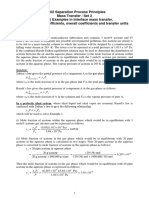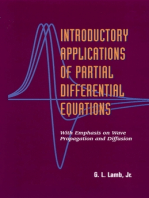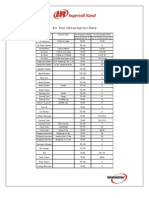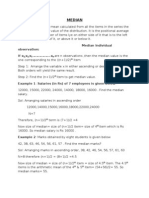Thermodynamic Flash Calculation
Uploaded by
romdhan88Thermodynamic Flash Calculation
Uploaded by
romdhan88P,T-Flash Calculations
Purpose of this lecture: To illustrate how P,T-Flash calculations can be performed either graphically or numerically Highlights The lever rule Step-by-step procedure for numerical P,T flash calculations Reading assignment: Ch. 14, pp. 551-554 (7th edition), or Ch. 14, pp. 532-535 (6th edition)
CHEE 311
Lecture 3
P,T Flash Calculations
If a stream consists of three components with widely differing volatilities, substantial separation of one component can be achieved using a simple flash unit. Vapour
Feed z1 z2 z3=1-z1-z2 Tf, Pf
P,T
y1 y2 y3=1-y1-y2 Liquid x1 x2 x3=1-x1-x2
Questions often posed: Given P, T and zi, what are the equilibrium phase compositions? Given P, T and the overall composition of the system, how much of each phase will we collect?
CHEE 311 Lecture 3 2
P-T Flash Calculations from a Phase Diagram
For some binary systems, you can often find a phase diagram in the range of conditions needed. For example, a Pxy diagram for the furan(1)/CCl4(2) system at 30C is illustrated to the right. Given T=30C, P= 300 mmHg, z1= 0.5 Determine x1, x2, y1, y2 and the fraction of the system that exists as a vapour (V) How can we do it? What equations can we use? What is the lever rule and how does It work?
CHEE 311 Lecture 3 3
Flash Calculations from a Phase Diagram
Txy diagrams can also be used. Consider the ethanol(1)/toluene(2) system at P = 1atm. Given T=90C, P= 760 mmHg, z1= 0.25 Determine x1, x2, y1, y2 and the fraction of the system that exists as a liquid (L) How about: T=90C, P= 760 mmHg, z1= 0.75? What do we do for feeds with more than two components?
CHEE 311 Lecture 3 4
Recall Gibbs Phase Rule F=2-+N What does it mean? What is it for? What can we do if we care about intensive variables and extensive variables?
CHEE 311
Lecture 3
Duhems Theorem:
SVNA10.2
For any closed system, formed initially from given masses of prescribed chemical species, the equilibrium state is completely determined when any two independent variables are fixed. What does this mean? What is it for? What does it have to do with flash calculations? Are flash drums open or closed systems? We specify T and P when we do flash calculations. If our feed mixture contains 26 components, do we need to specify more variables than if the feed contains only 3 components? If we specify T, can we also select the concentration of component 1 in the gas and the mass of the gas produced?
CHEE 311 Lecture 3 6
Duhems Theorem:
SVNA10.2
For any closed system, formed initially from given masses of prescribed chemical species, the equilibrium state is completely determined when any two independent variables are fixed. Why is Duhems Theorem true? Variables required to specify the intensive and extensive state: T,P Mole fractions Mass of each phase Independent equations to satisfy: Material balances on chemical species Equilibrium equations for chemical species # of variables - # of equations = 2
CHEE 311 Lecture 3 7
Flash Calculations: Checking for a two-phase system
Specifying T,P and zi, gives sufficient information for a flash calculation. How can we make sure that two phases exist at this P,T and overall composition? At a given T, the maximum pressure for which two phases exist is the BUBL P Why? At a given T, the minimum pressure for which two phases exist is the DEW P Why? We can perform a BUBL P calculation using xi = zi and a DEW P using yi = zi and check if the specified P is in this range. What if we dont have two phases? What would happen if there is only one phase and we do the flash calculation without checking?
CHEE 311 Lecture 3 8
Flash Calculations using Raoults Law
Given P,T and zi, calculate the compositions of the vapour and liquid phases and the phase fractions without the use of a phase diagram. Step 1. Determine Pisat for each component at T using Antoine eqn.
Step 2. Check for two phases by calculating DEWP and BUBLP using the composition, zi.
Step 3. Determine partition coefficients Ki from Raoults law
CHEE 311 Lecture 3 9
Flash Calculations from Raoults Law
Step 4. Choose a basis of 1 mole of feed and write mass balances: Overall: L+V = 1
z i (1) = x iL + y i V
Components:
i=1,2,,n
Step 5. Do some algebra to get:
yi =
zi K i 1 + V(K i 1)
CHEE 311
Lecture 3
10
Flash Calculations from Raoults Law
Step 6: Substitute into:
yi = 1
i =1
i =n
to get:
zi K i =1 i =1 1 + V (K i 1)
where, zi = overall mole fraction of component i V = vapour phase fraction Ki = partition coefficient for component i Step 7:
i =n
14.18
Solve for V, then yi and xi values. How do we solve for V?
CHEE 311 Lecture 3 11
You might also like
- 4.3. Consider The Flowsheet For The Manufacture of Vinyl Chloride in Figure 4.8100% (1)4.3. Consider The Flowsheet For The Manufacture of Vinyl Chloride in Figure 4.82 pages
- CHEN64341 Energy Systems Coursework Andrew Stefanus 10149409100% (1)CHEN64341 Energy Systems Coursework Andrew Stefanus 1014940912 pages
- At RT P VBVVB: Calculate Z, GR, HR and SR For Co2 at 325 K and 60 Bar Using R-K Eos. AnswerNo ratings yetAt RT P VBVVB: Calculate Z, GR, HR and SR For Co2 at 325 K and 60 Bar Using R-K Eos. Answer2 pages
- Simulink Development of Single Effect Evaporator Using MatlabNo ratings yetSimulink Development of Single Effect Evaporator Using Matlab12 pages
- McCabe-Thiele Distillation Column Design For A Methanol-Propanol SystemNo ratings yetMcCabe-Thiele Distillation Column Design For A Methanol-Propanol System12 pages
- LNG Process Selection Considerations For Future DevelopmentsNo ratings yetLNG Process Selection Considerations For Future Developments9 pages
- Download full Solution Manual for Introduction to Environmental Engineering – SI Version, 3rd Edition all chapters100% (23)Download full Solution Manual for Introduction to Environmental Engineering – SI Version, 3rd Edition all chapters26 pages
- Vapor-Liquid Equilibria. Ethylene Oxide - Acetaldehyde and Ethylene Oxide - Water Systems0% (1)Vapor-Liquid Equilibria. Ethylene Oxide - Acetaldehyde and Ethylene Oxide - Water Systems5 pages
- Tutorial Solid Liquid Extraction - Leaching 2022No ratings yetTutorial Solid Liquid Extraction - Leaching 202222 pages
- Rr410805 Process Modelling and SimulationNo ratings yetRr410805 Process Modelling and Simulation8 pages
- A Constant Volume Batch Reactor For Saponification Reaction PDFNo ratings yetA Constant Volume Batch Reactor For Saponification Reaction PDF49 pages
- Aspen Plus Example of CO2 Capture From Syngas For IGCC Using MEA - v12No ratings yetAspen Plus Example of CO2 Capture From Syngas For IGCC Using MEA - v128 pages
- PFR CSTR - Systems Overview and Protocols FinalNo ratings yetPFR CSTR - Systems Overview and Protocols Final20 pages
- Chemical Kinetics: Chung (Peter) Chieh Professor of Chemistry University of Waterloo Waterloo, Ontario, CanadaNo ratings yetChemical Kinetics: Chung (Peter) Chieh Professor of Chemistry University of Waterloo Waterloo, Ontario, Canada34 pages
- Design and Fabrication of A Multi-TubularNo ratings yetDesign and Fabrication of A Multi-Tubular14 pages
- CP302 Separation Process Principles Mass Transfer / Set 2 (Worked) Examples in Interface Mass Transfer, Mass Transfer Coefficients, Overall Coefficients and Transfer UnitsNo ratings yetCP302 Separation Process Principles Mass Transfer / Set 2 (Worked) Examples in Interface Mass Transfer, Mass Transfer Coefficients, Overall Coefficients and Transfer Units4 pages
- Material and Balance For Sohio Process That Produce Acrytonitrile0% (2)Material and Balance For Sohio Process That Produce Acrytonitrile2 pages
- BARKLEY and MOTARD-Decomposition of Nets, 1972No ratings yetBARKLEY and MOTARD-Decomposition of Nets, 197211 pages
- Introductory Applications of Partial Differential Equations: With Emphasis on Wave Propagation and DiffusionFrom EverandIntroductory Applications of Partial Differential Equations: With Emphasis on Wave Propagation and DiffusionNo ratings yet
- Chemical Reactor Analysis and Applications for the Practicing EngineerFrom EverandChemical Reactor Analysis and Applications for the Practicing EngineerNo ratings yet
- In-situ Characterization of Heterogeneous CatalystsFrom EverandIn-situ Characterization of Heterogeneous CatalystsJosé A. RodriguezNo ratings yet
- Design and Control of Distillation Systems for Separating AzeotropesFrom EverandDesign and Control of Distillation Systems for Separating AzeotropesNo ratings yet
- IEC 60034 Pt.11 Ch.3 (Thermal Protection)No ratings yetIEC 60034 Pt.11 Ch.3 (Thermal Protection)2 pages
- IEC 60034 Pt.11 Ch.2 (Thermal Protection)No ratings yetIEC 60034 Pt.11 Ch.2 (Thermal Protection)2 pages
- Heat and Material Balance of Gas Stripping Deaerator ColumnNo ratings yetHeat and Material Balance of Gas Stripping Deaerator Column1 page
- Matrix Operation Linear Programming: AlgorithmsNo ratings yetMatrix Operation Linear Programming: Algorithms28 pages
- For METTLER TOLEDO Titration Excellence Line: Selected ApplicationsNo ratings yetFor METTLER TOLEDO Titration Excellence Line: Selected Applications31 pages
- Lab Experiment 7: Introduction To Bode Plots, Phase and Gain MarginNo ratings yetLab Experiment 7: Introduction To Bode Plots, Phase and Gain Margin12 pages
- 5 - Lecture 5 - S-Plane To Z-Plane Mapping & Transfer Function - (2nd Term 2021-2022)No ratings yet5 - Lecture 5 - S-Plane To Z-Plane Mapping & Transfer Function - (2nd Term 2021-2022)12 pages
- Expert Professional Academy Pvt. Ltd. - Ca-Foundation: DD-271 by Ca Vinod ReddyNo ratings yetExpert Professional Academy Pvt. Ltd. - Ca-Foundation: DD-271 by Ca Vinod Reddy3 pages
- Table of Integrals: Products of Trigonometric Functions and Monomials Integrals of Inverse Trigonometric FunctionsNo ratings yetTable of Integrals: Products of Trigonometric Functions and Monomials Integrals of Inverse Trigonometric Functions2 pages
- Assignment 1 Stats Lab - (Aimel Hasan-0203)No ratings yetAssignment 1 Stats Lab - (Aimel Hasan-0203)3 pages
- Section 9.4 Lagrange Multipliers Problems 1-15 Odd, 19-25 OddNo ratings yetSection 9.4 Lagrange Multipliers Problems 1-15 Odd, 19-25 Odd4 pages
- Homework Exercises For Chapter 4 Solutions: Exercise 4.1No ratings yetHomework Exercises For Chapter 4 Solutions: Exercise 4.12 pages
- Fixed Point Theory and Applications: January 2011No ratings yetFixed Point Theory and Applications: January 201115 pages
- Tbi.b - (1) Research Assumption and Hypotheses100% (2)Tbi.b - (1) Research Assumption and Hypotheses5 pages
- Numerical Integration: Md. Mehedi HasanNo ratings yetNumerical Integration: Md. Mehedi Hasan14 pages
- Some Coincidence and Fixed Point Results For Hybrid ContractionNo ratings yetSome Coincidence and Fixed Point Results For Hybrid Contraction14 pages
- Definition: A Function F From A Set A To Set B Is A Rule of Correspondence That Assigns To EachNo ratings yetDefinition: A Function F From A Set A To Set B Is A Rule of Correspondence That Assigns To Each4 pages
- Introduction To Finite Element Method PDFNo ratings yetIntroduction To Finite Element Method PDF13 pages
- Quality Management System Equipment and Calibration Quiz Answer Key 2017 - v0.1 PDF100% (1)Quality Management System Equipment and Calibration Quiz Answer Key 2017 - v0.1 PDF1 page
- Pollution) : A New Device For Facilitating The Sequestration and Mineralization of (CO2)No ratings yetPollution) : A New Device For Facilitating The Sequestration and Mineralization of (CO2)3 pages
- 4.3. Consider The Flowsheet For The Manufacture of Vinyl Chloride in Figure 4.84.3. Consider The Flowsheet For The Manufacture of Vinyl Chloride in Figure 4.8
- CHEN64341 Energy Systems Coursework Andrew Stefanus 10149409CHEN64341 Energy Systems Coursework Andrew Stefanus 10149409
- At RT P VBVVB: Calculate Z, GR, HR and SR For Co2 at 325 K and 60 Bar Using R-K Eos. AnswerAt RT P VBVVB: Calculate Z, GR, HR and SR For Co2 at 325 K and 60 Bar Using R-K Eos. Answer
- Simulink Development of Single Effect Evaporator Using MatlabSimulink Development of Single Effect Evaporator Using Matlab
- McCabe-Thiele Distillation Column Design For A Methanol-Propanol SystemMcCabe-Thiele Distillation Column Design For A Methanol-Propanol System
- LNG Process Selection Considerations For Future DevelopmentsLNG Process Selection Considerations For Future Developments
- Download full Solution Manual for Introduction to Environmental Engineering – SI Version, 3rd Edition all chaptersDownload full Solution Manual for Introduction to Environmental Engineering – SI Version, 3rd Edition all chapters
- Vapor-Liquid Equilibria. Ethylene Oxide - Acetaldehyde and Ethylene Oxide - Water SystemsVapor-Liquid Equilibria. Ethylene Oxide - Acetaldehyde and Ethylene Oxide - Water Systems
- A Constant Volume Batch Reactor For Saponification Reaction PDFA Constant Volume Batch Reactor For Saponification Reaction PDF
- Aspen Plus Example of CO2 Capture From Syngas For IGCC Using MEA - v12Aspen Plus Example of CO2 Capture From Syngas For IGCC Using MEA - v12
- Chemical Kinetics: Chung (Peter) Chieh Professor of Chemistry University of Waterloo Waterloo, Ontario, CanadaChemical Kinetics: Chung (Peter) Chieh Professor of Chemistry University of Waterloo Waterloo, Ontario, Canada
- CP302 Separation Process Principles Mass Transfer / Set 2 (Worked) Examples in Interface Mass Transfer, Mass Transfer Coefficients, Overall Coefficients and Transfer UnitsCP302 Separation Process Principles Mass Transfer / Set 2 (Worked) Examples in Interface Mass Transfer, Mass Transfer Coefficients, Overall Coefficients and Transfer Units
- Material and Balance For Sohio Process That Produce AcrytonitrileMaterial and Balance For Sohio Process That Produce Acrytonitrile
- Introductory Applications of Partial Differential Equations: With Emphasis on Wave Propagation and DiffusionFrom EverandIntroductory Applications of Partial Differential Equations: With Emphasis on Wave Propagation and Diffusion
- Environmental Regulatory Calculations HandbookFrom EverandEnvironmental Regulatory Calculations Handbook
- Chemical Reactor Analysis and Applications for the Practicing EngineerFrom EverandChemical Reactor Analysis and Applications for the Practicing Engineer
- In-situ Characterization of Heterogeneous CatalystsFrom EverandIn-situ Characterization of Heterogeneous Catalysts
- Understanding Distillation Using Column Profile MapsFrom EverandUnderstanding Distillation Using Column Profile Maps
- Chemical Reactor Design, Optimization, and ScaleupFrom EverandChemical Reactor Design, Optimization, and Scaleup
- Design and Control of Distillation Systems for Separating AzeotropesFrom EverandDesign and Control of Distillation Systems for Separating Azeotropes
- Heat and Material Balance of Gas Stripping Deaerator ColumnHeat and Material Balance of Gas Stripping Deaerator Column
- For METTLER TOLEDO Titration Excellence Line: Selected ApplicationsFor METTLER TOLEDO Titration Excellence Line: Selected Applications
- Lab Experiment 7: Introduction To Bode Plots, Phase and Gain MarginLab Experiment 7: Introduction To Bode Plots, Phase and Gain Margin
- 5 - Lecture 5 - S-Plane To Z-Plane Mapping & Transfer Function - (2nd Term 2021-2022)5 - Lecture 5 - S-Plane To Z-Plane Mapping & Transfer Function - (2nd Term 2021-2022)
- Expert Professional Academy Pvt. Ltd. - Ca-Foundation: DD-271 by Ca Vinod ReddyExpert Professional Academy Pvt. Ltd. - Ca-Foundation: DD-271 by Ca Vinod Reddy
- Table of Integrals: Products of Trigonometric Functions and Monomials Integrals of Inverse Trigonometric FunctionsTable of Integrals: Products of Trigonometric Functions and Monomials Integrals of Inverse Trigonometric Functions
- Section 9.4 Lagrange Multipliers Problems 1-15 Odd, 19-25 OddSection 9.4 Lagrange Multipliers Problems 1-15 Odd, 19-25 Odd
- Homework Exercises For Chapter 4 Solutions: Exercise 4.1Homework Exercises For Chapter 4 Solutions: Exercise 4.1
- Some Coincidence and Fixed Point Results For Hybrid ContractionSome Coincidence and Fixed Point Results For Hybrid Contraction
- Definition: A Function F From A Set A To Set B Is A Rule of Correspondence That Assigns To EachDefinition: A Function F From A Set A To Set B Is A Rule of Correspondence That Assigns To Each
- Quality Management System Equipment and Calibration Quiz Answer Key 2017 - v0.1 PDFQuality Management System Equipment and Calibration Quiz Answer Key 2017 - v0.1 PDF
- Pollution) : A New Device For Facilitating The Sequestration and Mineralization of (CO2)Pollution) : A New Device For Facilitating The Sequestration and Mineralization of (CO2)









































































































